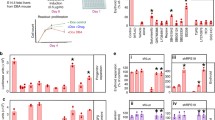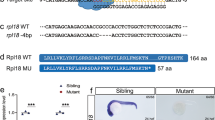Abstract
Human severe combined immunodeficiencies (SCID) are phenotypically and genotypically heterogeneous diseases1. Reticular dysgenesis is the most severe form of inborn SCID. It is characterized by absence of granulocytes and almost complete deficiency of lymphocytes in peripheral blood, hypoplasia of the thymus and secondary lymphoid organs, and lack of innate and adaptive humoral and cellular immune functions, leading to fatal septicemia within days after birth2,3,4,5,6,7,8. In bone marrow of individuals with reticular dysgenesis, myeloid differentiation is blocked at the promyelocytic stage, whereas erythro- and megakaryocytic maturation is generally normal. These features exclude a defect in hematopoietic stem cells but point to a unique aberration of the myelo-lymphoid lineages. The dramatic clinical course of reticular dysgenesis and its unique hematological phenotype have spurred interest in the unknown genetic basis of this syndrome. Here we show that the gene encoding the mitochondrial energy metabolism enzyme adenylate kinase 2 (AK2) is mutated in individuals with reticular dysgenesis. Knockdown of zebrafish ak2 also leads to aberrant leukocyte development, stressing the evolutionarily conserved role of AK2. Our results provide in vivo evidence for AK2 selectivity in leukocyte differentiation. These observations suggest that reticular dysgenesis is the first example of a human immunodeficiency syndrome that is causally linked to energy metabolism and that can therefore be classified as a mitochondriopathy.
This is a preview of subscription content, access via your institution
Access options
Subscribe to this journal
Receive 12 print issues and online access
$209.00 per year
only $17.42 per issue
Buy this article
- Purchase on Springer Link
- Instant access to full article PDF
Prices may be subject to local taxes which are calculated during checkout




Similar content being viewed by others
Accession codes
References
Geha, R.S. et al. Primary immunodeficiency diseases: an update from the International Union of Immunological Societies Primary Immunodeficiency Diseases Classification Committee. J. Allergy Clin. Immunol. 120, 776–794 (2007).
Alonso, K., Dew, J.M. & Starke, W.R. Thymic alymphoplasia and congenital aleukocytosis (reticular dysgenesia). Arch. Pathol. 94, 179–183 (1972).
de Vaal, O. & Seynhaeve, V. Reticular dysgenesia. Lancet 2, 1123–1125 (1959).
Emile, J.F., Durandy, A., Le Deist, F., Fischer, A. & Brousse, N. Epidermal Langerhans' cells in children with primary T-cell immune deficiencies. J. Pathol. 183, 70–74 (1997).
Espanol, T. et al. Reticular dysgenesis: report of two brothers. Clin. Exp. Immunol. 38, 615–620 (1979).
Gitlin, D., Vawter, G. & Craig, J.M. Thymic alymphoplasia and congenital aleukocytosis. Pediatrics 33, 184–192 (1964).
Haas, R.J. et al. Congenital immunodeficiency and agranulocytosis (reticular dysgenesia). Acta Paediatr. Scand. 66, 279–283 (1977).
Ownby, D.R., Pizzo, S., Blackmon, L., Gall, S.A. & Buckley, R.H. Severe combined immunodeficiency with leukopenia (reticular dysgenesis) in siblings: immunologic and histopathologic findings. J. Pediatr. 89, 382–387 (1976).
DiMauro, S. & Schon, E.A. Mitochondrial respiratory-chain diseases. N. Engl. J. Med. 348, 2656–2668 (2003).
Wallace, D.C. Mouse models for mitochondrial disease. Am. J. Med. Genet. 106, 71–93 (2001).
Dzeja, P.P. & Terzic, A. Phosphotransfer networks and cellular energetics. J. Exp. Biol. 206, 2039–2047 (2003).
Schlauderer, G.J., Proba, K. & Schulz, G.E. Structure of a mutant adenylate kinase ligated with an ATP-analogue showing domain closure over ATP. J. Mol. Biol. 256, 223–227 (1996).
Small, T.N. et al. Association of reticular dysgenesis (thymic alymphoplasia and congenital aleukocytosis) with bilateral sensorineural deafness. J. Pediatr. 135, 387–389 (1999).
Chandra, D. et al. Intracellular nucleotides act as critical prosurvival factors by binding to cytochrome C and inhibiting apoptosome. Cell 125, 1333–1346 (2006).
Riedl, S.J., Li, W., Chao, Y., Schwarzenbacher, R. & Shi, Y. Structure of the apoptotic protease-activating factor 1 bound to ADP. Nature 434, 926–933 (2005).
Krishnan, K.J. et al. What causes mitochondrial DNA deletions in human cells? Nat. Genet. 40, 275–279 (2008).
Müller, A., Holzmann, K. & Kestler, K. Visualization of genomic aberrations using Affymetrix SNP arrays. Bioinformatics 23, 496–497 (2007).
Oxtoby, E. & Jowett, T. Cloning of the zebrafish krox-20 gene (krx-20) and its expression during hindbrain development. Nucleic Acids Res. 21, 1087–1095 (1993).
Schorpp, M. et al. Conserved functions of Ikaros in vertebrate lymphocyte development: genetic evidence for distinct larval and adult phases of T cell development and two lineages of B cells in zebrafish. J. Immunol. 177, 2463–2476 (2006).
Friesen, C., Kiess, Y. & Debatin, K.M. A critical role of glutathione in determining apoptosis sensitivity and resistance in leukemia cells. Cell Death Differ. 11, S73–S85 (2004).
Acknowledgements
We acknowledge the technical assistance of S. Braun, I. Janz, K. Heinrich, T. Kersten and S. Radecke. We are grateful to M. Schorpp for helpful advice. These studies were supported by the German Red Cross Blood Service Baden-Wuerttemberg-Hessen to K.S., the Deutsche Forschungsgemeinschaft (SFB620) and the Max-Planck Society to T.B.
Author information
Authors and Affiliations
Contributions
U.P., M.H., T.B. and K.S. designed the study. M.H., A.S. and W.F. cared for the subjects, collected clinical data and performed immunophenotyping. I.H. and T.B. contributed the zebrafish in situ hybridizations. K.H. performed and K.H. and K.S. analyzed the chip experiments. U.P., M.H., E.-M.R. and K.S. worked on the RT-PCR screen, the molecular and expression data and on mitochondrial analyses. C.F. performed the apoptosis, mitochondrial membrane potential and ROS assays. T.F.B. collected the immunohistochemistry data. E.-M.R. and M.T.R. did the FACS sorting. U.P., M.H., T.B. and K.S. wrote the paper.
Corresponding author
Supplementary information
Supplementary Text and Figures
Supplementary Tables 1–4 and Supplementary Figures 1–7 (PDF 579 kb)
Rights and permissions
About this article
Cite this article
Pannicke, U., Hönig, M., Hess, I. et al. Reticular dysgenesis (aleukocytosis) is caused by mutations in the gene encoding mitochondrial adenylate kinase 2. Nat Genet 41, 101–105 (2009). https://doi.org/10.1038/ng.265
Received:
Accepted:
Published:
Issue Date:
DOI: https://doi.org/10.1038/ng.265
This article is cited by
-
AK2 is an AMP-sensing negative regulator of BRAF in tumorigenesis
Cell Death & Disease (2022)
-
A prognostic index based on an eleven gene signature to predict systemic recurrences in colorectal cancer
Experimental & Molecular Medicine (2019)
-
Prognostic and therapeutic potential of Adenylate kinase 2 in lung adenocarcinoma
Scientific Reports (2019)
-
Reticular Dysgenesis and Mitochondriopathy Induced by Adenylate Kinase 2 Deficiency with Atypical Presentation
Scientific Reports (2019)
-
Adenylate Kinase: A Ubiquitous Enzyme Correlated with Medical Conditions
The Protein Journal (2019)



